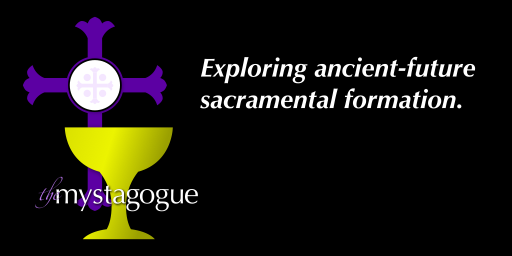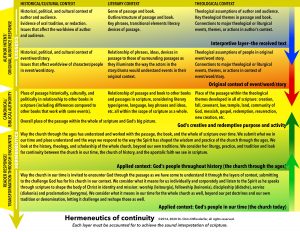Another attempt to visually represent a rich, dynamic process!
Hermeneutics is the entire process of interpretation, from exegesis to application, while exegesis (as the first part of that process) is specifically the process through which we establish the author intent, asking the questions about historical/cultural, literary, and theological context to establish the intended meaning of the passage.
When we work exegetically, we are working with what we might call two layers of context: the community of God as they used the book or passage as scripture (which is an interpretive layer, which means the community was interpreting what was received through oral and/or written tradition), and the community of God in which the events or issues were first experienced. As we work exegetically with those layers of context, we also consider, then, the biggest context into which all scripture fits: the big picture of God’s creative and redemptive purpose and activity, considering how the book or passage fits in that overall story and is it be understood in light of all that God has been doing (and plans to do) with his people, the world, and the entire cosmos.
When we understand the text well, having worked through those initial layers of context, we have essentially completed what we call the exegetical process, and we should have a pretty good sense of the meaning and purpose of the passage. But to understand, then, how we should see the church in our time in light of what we have discovered, we work through the remaining two layers of context. We need to make sure we account for the ways the church has understood and used the truth of scripture over time, drawing on things like apostolic faith and practice as it was realized through the early centuries of the church under the guidance of the early church fathers. We consider what we have discovered in the context of the ongoing faith, practice, and scholarship of the church over time such that when we finally consider what the passage means for us in our time and place, we are doing so in ways that take into account the continuity of the church’s theology and practice over time as well.
When we apply the text in the context of the community of God in our time, then, we have a rich sense of the way the text fits in that great big picture, and we can draw from the text both challenges to our assumptions and desires about God and what he has to say to us and a good sense of what he intends for us to be and do that fits in continuity with all he has said and done in and through his people through time, offering a much better-grounded sense of scripture and its meaning.
An example from the gospels might help:
When we start to approach any passage in the gospels, we are starting essentially wth what the author has put into writing to communicate with his audience (the church in his time and the issues he intends to address as he draws on the things Jesus said and did to do so). We enter the text by way of the ‘interpretive’ layer of the received text, the layer of the gospel writers, their audiences (the church in their time) and what they saw as especially significant about Jesus’ identity, purpose, and message.
There are other layers about which we need to be concerned if we are to place our exegesis in even deeper context. In the gospels, as with any historical narrative, for instance, we have the following layers of context to consider:
- Jesus, his audience, their expectations, and his message to them (the original context of the events as they happened decades before the gospel writers dealt with them).
- The gospels as they fit within the full sweep of God’s creative and redemptive purpose and activity, which is reflected in the perspectives of Christ, the gospel writers, and the church through the ages (biblical theology–the canonical context).
- The church as it circulated and used the gospels in worship and then came to affirm them, together, as the normative witness to Christ for the whole church (the applied context–as it is historically been understood).
- And finally the church in our time as it too receives the gospels as well as all of the reflection on them by the church through the ages as the authentic and normative witness to Christ as well as the understanding of all that he meant and means for the church in every age (the applied context–as it is contemporary to us).
With exegesis, if we are doing this well, we start with those first three contexts, making sure we consider the historical/cultural and theological context in which Christ was working (asking good questions about his intent in doing and saying what he was), and making sure we consider the interpretive context in which the author of each gospel was working to interpret and apply the tradition of the church about Christ to the church in their context (asking good questions about the author’s intent in using the events in Jesus’ life as he does, thinking of the historical/cultural, literary, and theological assumptions and issues related to the church in the time and region each gospel writer is addressing). All of this is related to the way God worked with his people in light of his covenant purpose for them and the world.
With the rest of the hermeneutical process, we work through the remaining layers of context to fit the church through the ages, and the church in our time, into what we have discovered (we call it ‘application’, but that implies that we take something from the text, and I tend to think a better image would really be one of ‘submission’, as we submit who we are and what we do to all that God has to say through the wisdom and experiences of his people that we have in scripture).

